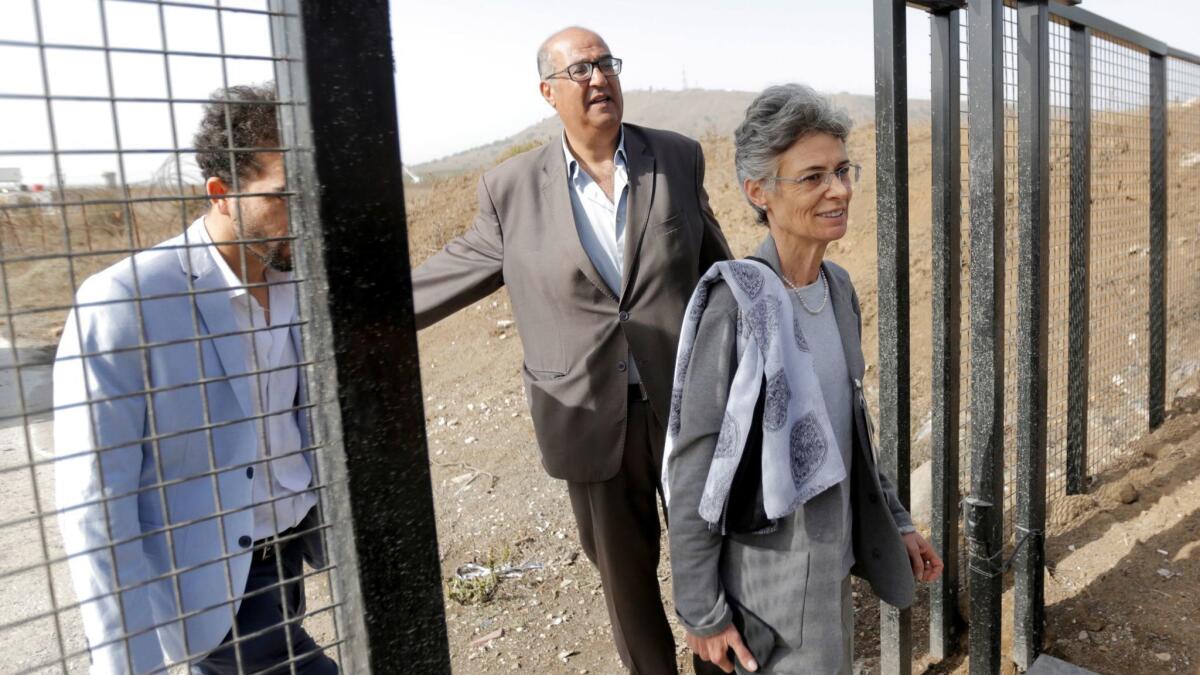The latest sign that the Syrian civil war is winding down? Borders are reopened to Jordan and Golan Heights

- Share via
Reporting from Damascus, Syria — Syria reopened a pair of long-dormant border crossings linking the country to Jordan and to Israeli-occupied territory on Monday, marking the return of its prewar status as a crucial transit corridor in the region.
A string of cars, many of them waiting since Sunday night, according to Jordanian news outlets, made their way through a checkpoint on the Jordanian side of the border and into Syria at the Nassib border gate when it opened at 8 a.m.
Though there was no official opening ceremony, authorities on both sides lauded the move as a boon for regional trade.
Jordanian government spokeswoman Jumana Ghunaimat described the crossing as a “vital commercial lifeline for commercial movement between Jordan and Syria and through them to several countries.”
Samer Dibs, head of Syria’s Chamber of Industry, said in an interview with state-sponsored Jordanian broadcaster Al Mamlaka TV that the crossing’s “importance is a shared one for Syria, Jordan and Lebanon … as well as for gulf nations.”
He added that it would be the gateway for Jordanian companies to participate in Syria’s postwar reconstruction. Syria has been engulfed in a civil war since 2011, as rebel forces, some backed by the United States, have attempted to overthrow the government of President Bashar Assad. With help from Russia and Iran, Assad has been able to beat back the uprising and appears on the verge of victory.
This year, a Russian-backed campaign dislodged the rebels from their enclave in Dara, the southern Syrian province where the uprising began. The government recaptured the southwestern province of Quneitra in the same offensive.
The Nassib crossing is the primary passageway on the 235-mile border Jordan shares with its northern neighbor. Its proximity to Dara spurred Jordanian authorities to restrict it to only commercial traffic within the first few months of the crisis.
Nassib was completely shut in 2015 after Al Qaeda-affiliated jihadis chased out Syrian army soldiers and went on a rampage, looting an estimated $150 million of goods and equipment in the free-trade zone between the two countries.
Its closure meant the loss of $1.5 billion in annual trade, as well as hundreds of millions of dollars for truckers and farmers who used it to deliver goods to Turkey as well as European markets, according to Jordanian officials.
It was a crippling blow to Jordan’s already weak economy, and denied Jordanians access to an area so important it was once called “Jordan’s lung.”
Jordanian farmers had relied on the Nassib crossing to send produce such as tomatoes to markets as far as Turkey and beyond. They now had to dispatch their crops by sea, either through the southern seaport of Aqaba or to Haifa in Israel.
Moreover, Syria’s significantly lower prices, not to mention its local industries producing goods such as underwear and fruit jams, drew droves of Jordanians across the border every week to stock their larder and fill their wardrobe.
Meanwhile, Lebanon, which had used Nassib as a conduit to the Persian Gulf states, suffered a 35% decrease in its exports, according to its then-minister of economy.
The border closure also increased Syria’s isolation, leaving it with a single land crossing to Lebanon. (The rebels had commandeered the country’s borders with Turkey and Iraq.)
Discussions between Damascus and Amman had been underway to open the border since last year, after a Moscow-brokered cease-fire agreement took effect.
But they had been frozen because of the U.S. insistence to deny Assad any economic relief “in order to force a fundamental political change,” said Sam Heller, a Syria expert at the International Crisis Group think tank.
“This opening of Nassib seems to be an instance where Jordan has prioritized its interest over the current American project in Syria,” said Heller in a phone interview on Monday.
Lebanese President Michel Aoun welcomed the resumption of traffic between Jordan and Syria, saying in a statement carried by state media on Monday that it would “benefit Lebanon and reconnect it by land to its Arab depth, revive the various productive sectors and reduce the cost of exporting goods from Lebanon to Arab countries.”
Monday also marked the return of U.N. observers to Quneitra, home to the only crossing between Syria and the Israeli-occupied Golan Heights.

The peacekeepers, part of a U.N. mission established in 1974 to monitor a cease-fire in the wake of Israel’s occupation of the area in 1967, had left Quneitra in 2014 after rebel factions kidnapped some of them during an attack on Syrian government troops.
The opening of the Quneitra crossing comes “after the great victory achieved by the Syrian Arab army against terrorism,” said Humam Dbayat, the provincial governor, in a statement released Monday to state media.
The Syrian government views all the opposition’s fighters as terrorists who are backed by the country’s regional and international enemies.
Although it was only open to the U.N. on Monday, the Quneitra crossing would later allow the passage of Syrian Druze residing in Israeli-occupied lands.
Monday’s developments come as part of a larger plan to open up major international highways in Syria, a country that had served as a transit hub linking Jordan, Lebanon, Turkey and Iraq.
A cease-fire agreement between the government and Turkish-backed rebels, set to come into effect Monday, aims to reopen the M5 and M4 highways. They form the backbone of the country’s road network.
Meanwhile, the Albukamal crossing with Iraq will be “opened soon,” Iraqi Foreign Minister Ibrahim Jafari said Monday at a news conference in the Syrian capital, Damascus.
“No one,” said Jafari, “can marginalize [Syria’s] pivotal role in the region.”
Twitter: @nabihbulos
More to Read
Sign up for Essential California
The most important California stories and recommendations in your inbox every morning.
You may occasionally receive promotional content from the Los Angeles Times.














